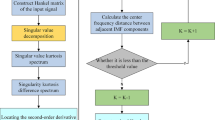Abstract
The defected rolling element bearing produces a non-stationary vibration signal, and these vibration signals are generally immersed with heavy noise. When non-stationary and background noise vibration signals are observed, the feature frequency of defected bearings is challenging to extract. This research paper introduces a hybrid rolling element-bearing fault investigation approach. This hybrid method of fault investigation uses transient invariant (TI) denoising with a circular shift to diminish the background noise data from the original signal. Then purified vibration signal is obtained by eliminating the background noise from the original signal. After removing background noise, the adaptive method called the empirical mode decomposition (EMD) is applied to decompose a non-stationary signal. EMD decomposes the non-stationary signal into an intrinsic mode function (IMF), a stationary component. However, the selection of maximum energies IMFs is a challenging task. Correlation coefficient investigation is then applied to choose the IMFs having maximum energies IMFs and reject the other pseudo-low-frequency component of IMFs. Implement envelope spectrum investigation to extract fault feature frequency from selected IMFs. Numerical simulation and test data from the defected bearing validate the suggested hybrid method with inner race bearing, outer race bearing, and rolling element defects. The outcome shows that the TI denoising with cycle spin, the EMD, and the envelope spectrum is feasible and effective in detecting rolling element-bearing faults.













Similar content being viewed by others
Abbreviations
- TI:
-
Transient invariant
- REB:
-
Rolling element bearing
- SANC:
-
Self-adaptive noise cancellation
- FT:
-
Fourier Transform
- \({S}_{h}\) :
-
Time-shift
- H:
-
Range of shift
- \(Ave\) :
-
Average operator
- \(y\left(t\right)\) :
-
Simulated (artificial) signal
- \({y}_{1}\left(t\right)\) :
-
Original signal combining two harmonic waves
- \({y}_{2}\left(t\right)\) :
-
Gaussian noise
- SNR:
-
Signal-to-noise ratio
- \({\upmu }_{{\text{i}}}\) :
-
Correlation coefficient
- \(\uplambda\) :
-
Hard threshold
- \(\upeta\) :
-
Ratio factor
- CWRU:
-
Case Western Reserve University
- EDM:
-
Electro-discharge machine
- IR:
-
Inner race
- OR:
-
Outer race
References
P. Agrawal, Diagnosis and classifications of bearing faults using artificial neural network and support vector machine. J. Inst. Eng. Ser. C 101(1), 61–72 (2019)
J. Xiang, Y. Zhong, A fault detection strategy using the enhancement ensemble empirical mode decomposition and random decrement technique. Microelectron. Reliab. 75, 317–326 (2017)
X. Qin, Q. Li, X. Dong, S. Lv, The fault diagnosis of rolling bearing based on ensemble empirical mode decomposition and random forest. Shock Vib. 2017 (2017)
S. Zhao, L. Liang, G. Xu, J. Wang, Quantitative diagnosis of a spall-like fault of a rolling element bearing by empirical mode decomposition and the approximate entropy method. Mech. Syst. Signal Process., 1–24 (2013)
P. Jayaswal, A.K. Wadhwani, K.B. Mulchandani, Machine fault signature analysis. Int. J. Rotating Mach. 2008, 1–10 (2008)
I. El-thalji, E. Jantunen, A summary of fault modelling and predictive health monitoring of rolling element bearings. Mech. Syst. Signal Process., 1–21 (2015)
T. Guo, Z. Deng, An improved EMD method based on the multi-objective optimization and its application to fault feature extraction of rolling bearing. Appl. Acoust. 127, 46–62 (2017)
V. Sharma, A. Parey, Frequency domain averaging based experimental evaluation of gear fault without tachometer for fluctuating speed conditions. Mech. Syst. Signal Process. 85, 278–295 (2017)
J. Zheng, Rolling bearing fault diagnosis based on partially ensemble empirical mode decomposition and variable predictive model-based class discrimination. Arch. Civil Mech. Eng. 6, 784–794 (2016)
G. Yang, X. Sun, M. Zhang, X. Li, X. Liu, Study on ways to restrain end effect of Hilbert-Huang transform. J. Comput. 25(3), 22–31 (2014)
D.L. Donoho, De-noising by soft-thresholding. IEEE Trans. Inf. Theory 41(3), 613–627 (1995)
R.R. Coifman, D.L. Donoho, Translation-Invariant De-Noising (Springer, New York, 1995)
N.E. Huang, Z. Shen, S.R. Long, M.L. Wu, H.H. Shih et al., The empirical mode decomposition and Hilbert spectrum for nonlinear and non-stationary time series analysis. Proc. R. Soc. Lond. Ser. A 454, 903–995 (1998)
X. Xue, J. Zhou, Y. Xu, W. Zhu, C. Li, An adaptively fast ensemble empirical mode decomposition method and its applications to rolling element bearing fault diagnosis. Mech. Syst. Signal Process. 62–63, 444–459 (2015)
J. Ben, N. Fnaiech, L. Saidi, B. Chebel-morello, F. Fnaiech, Application of empirical mode decomposition and artificial neural network for automatic bearing fault diagnosis based on vibration signals. Appl. Acoust. 89, 16–27 (2015)
Bearing Data Center, Case Western Reserve University. http://csegroups.case.edu/bearingdatacenter/pages/download-data-file.
Funding
The authors have not disclosed any funding.
Author information
Authors and Affiliations
Corresponding author
Ethics declarations
Conflict of interests
The authors declare that they have no known competing financial interests or personal relationships that could have appeared to influence the work reported in this paper.
Additional information
Publisher's Note
Springer Nature remains neutral with regard to jurisdictional claims in published maps and institutional affiliations.
Rights and permissions
Springer Nature or its licensor (e.g. a society or other partner) holds exclusive rights to this article under a publishing agreement with the author(s) or other rightsholder(s); author self-archiving of the accepted manuscript version of this article is solely governed by the terms of such publishing agreement and applicable law.
About this article
Cite this article
Tomar, A.S., Jayaswal, P. Rolling Element Bearing Fault Investigation Based on Translation Invariant Wavelet Means Denoising and Empirical Mode Decomposition (EMD). J. Inst. Eng. India Ser. C 105, 127–140 (2024). https://doi.org/10.1007/s40032-023-01016-w
Received:
Accepted:
Published:
Issue Date:
DOI: https://doi.org/10.1007/s40032-023-01016-w



